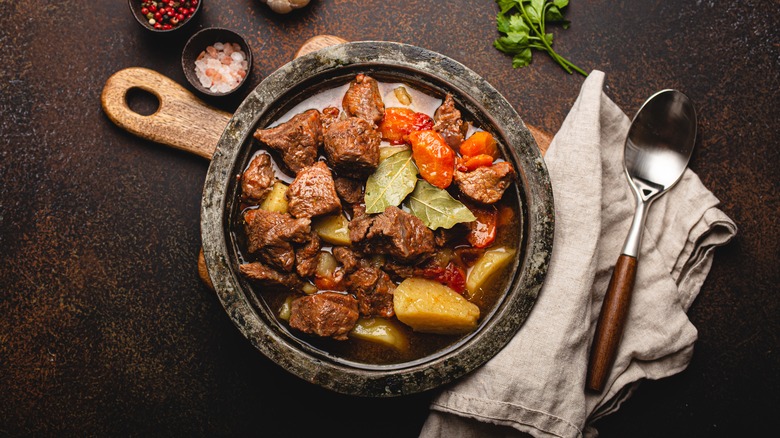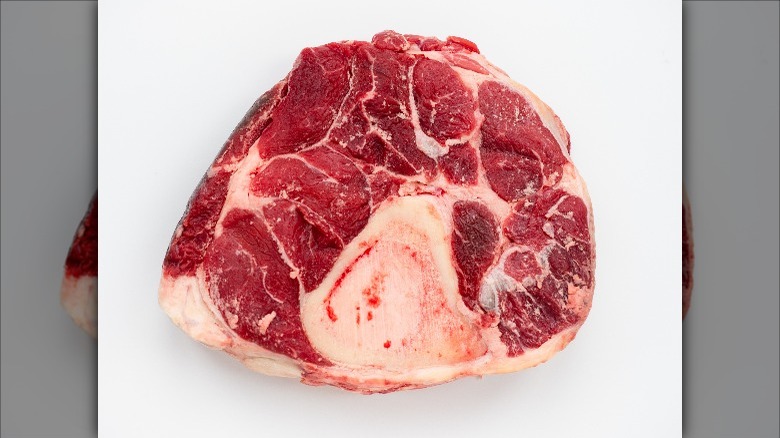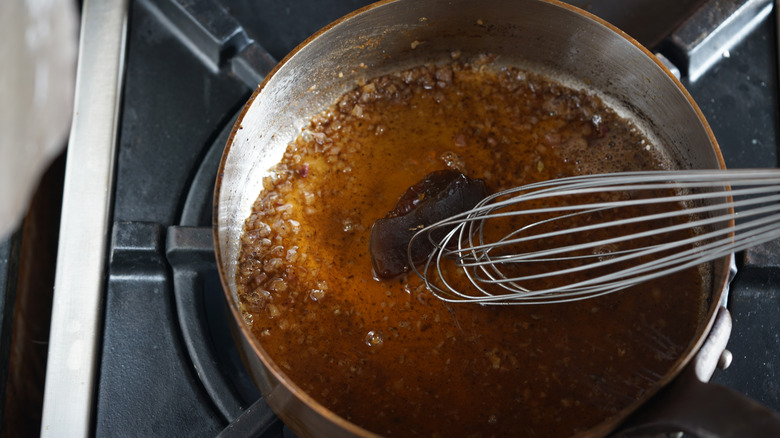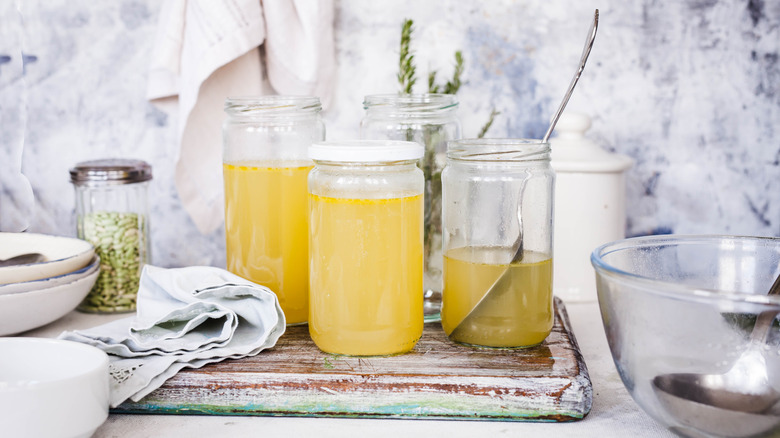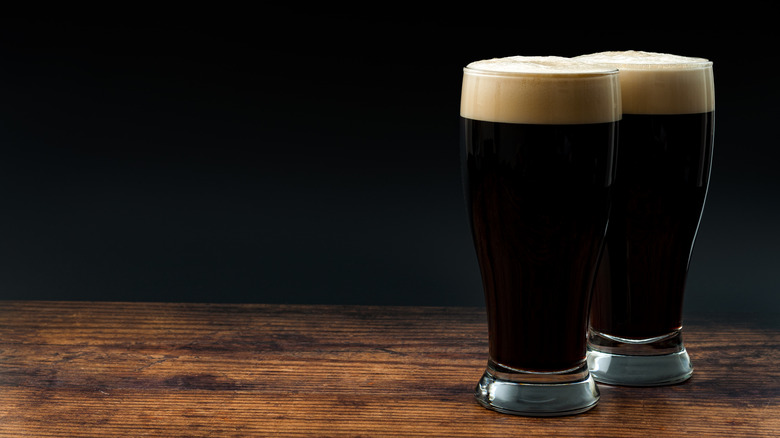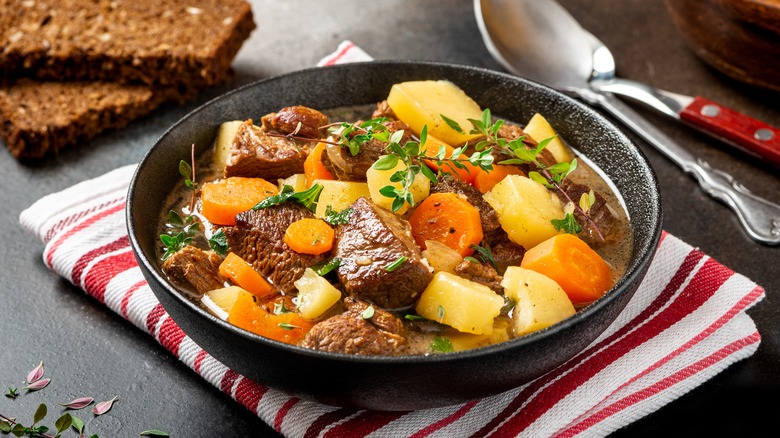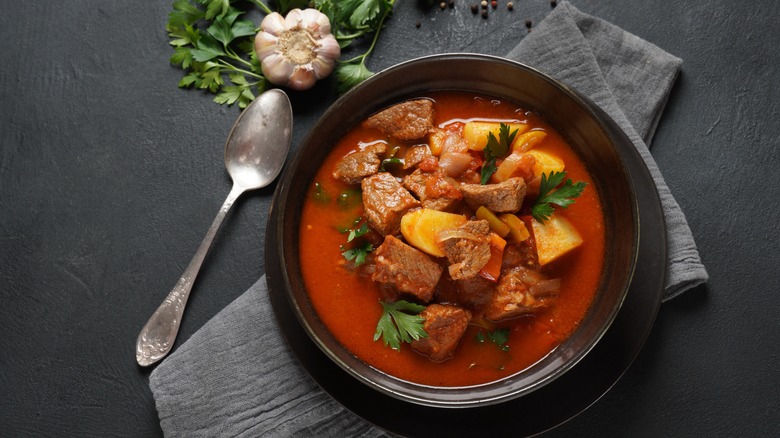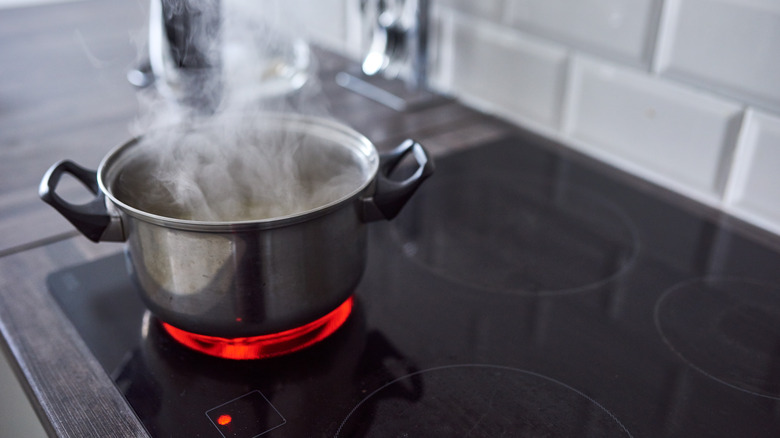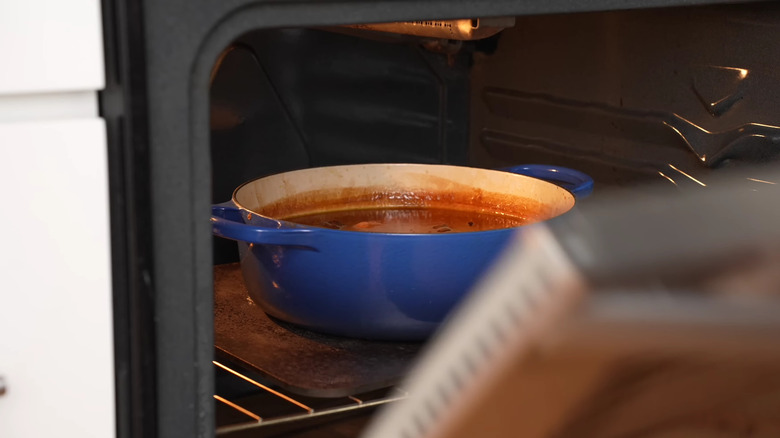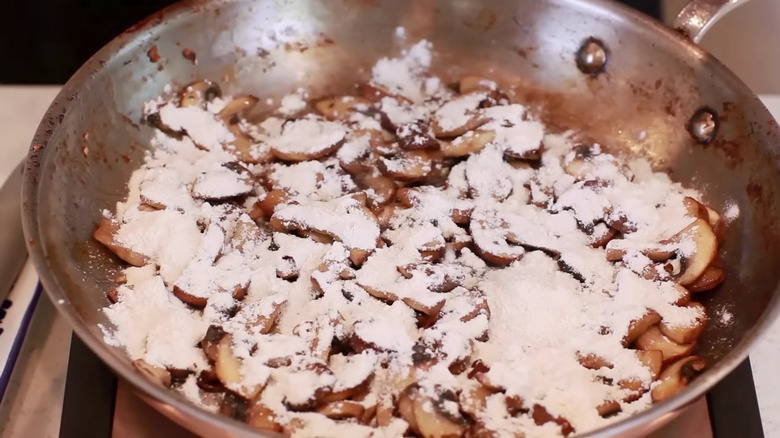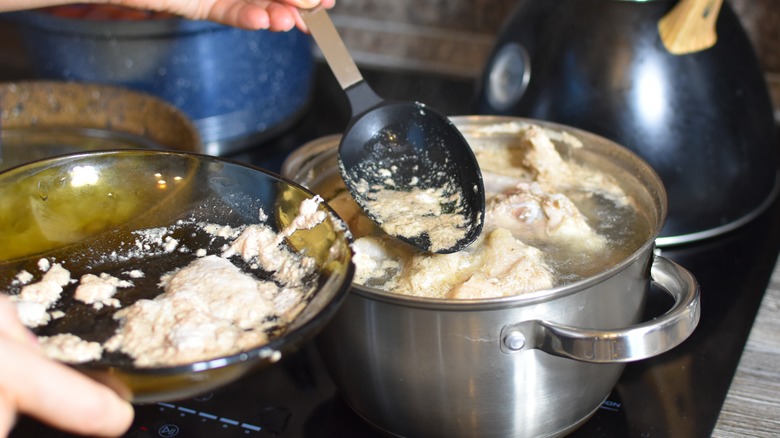Beef Stew Mistakes You Need To Avoid
Countries all over the world have their own version of beef stew. This is for good reason, as stewing, a form of slow cooking, can transform otherwise tough cuts of meat into something tender and intensely flavorful. As a result, beef stew has long been an economical, satiating dish that is fundamental to the daily lives of many.
In the modern day, beef stew's popularity has been hindered by its unphotogenic appearance and working-class roots. The dish is routinely pigeonholed as something that is made for family and not guests or paying customers. Aside from being inherently classist, this preconception is incorrect. Like many seemingly simple dishes, beef stew is easy to make and a pleasure to eat. There's nothing shameful about that.
Moreover, the easiest dishes to make are often the most difficult to master. That's because every component has a precious part to play, and each cooking technique is vital to success. Because of this, many mistakes can vastly impact the quality of beef stew. We're highlighting several of these in the hope that avoiding them will help your beef stew to receive the praise it deserves.
Using the wrong cut of meat
Beef is both the eponymous ingredient of beef stew and its most important component. Some cooks might associate cost with quality and are tempted to use expensive cuts such as filet mignon or ribeye steaks for beef stew. However, this is a mistake. These cuts are far too tender and will likely dry out during the stew's long cooking process.
Cuts that are lean and filled with connective tissue are the best option for beef stew. That's because collagen, which is found in those connective tissues, breaks down into gelatin during long cooking processes. This gelatin imparts a rich flavor and a silky texture to the beef stew.
Several cuts of beef are both lean and filled with connective tissue, chuck being one of them. Coming from the upper back and shoulder of cows, chuck is also readily available and affordable. As chef Brian Theis told HuffPost, "chuck is easy to find at most grocers, [it's] affordable, and [it's] succulent due to the connective tissues that are marbled into the meat. Chuck is very moist and doesn't dry out during [slow cooking] because of its release of gelatin."
Bone-in cuts like oxtail, beef shin, and short ribs are also well-suited to stews. The bone brings flavor to the pot as does the bone marrow that seeps out during cooking.
Not browning the meat
Just about every cut of beef will benefit from browning, a process that adds immense amounts of flavor thanks to the complex series of chemical changes known as the Maillard reaction. The caramelized crust that develops on the outside of the beef during this process adds color and flavor to the dish, making this an essential step for every stew.
As the Maillard reaction occurs at temperatures above 280 degrees, pans must be ripping hot before the meat is added. The reaction also requires a dry environment. However, meat contains liquid that seeps out during cooking and inhibits the Maillard reaction, losing moisture without gaining any flavor. If left too long, the meat can even become overcooked, resulting in a dry, chewy protein that will ruin the stew.
To minimize moisture loss and maximize browning, quickly sear your beef while it is in one piece. Once browned, the beef should rest before it's diced and added back to the stew. Searing it in this manner also ensures the beef remains raw in the middle, allowing it to be cooked to perfection during stewing.
Forgetting to deglaze the pan
If done properly, searing beef results in browned pieces of meat that stick to the pan. While they might look like a mess, these morsels (also known as fond) carry a huge amount of flavor and should not be wasted.
Deglazing frees that fond from the pan and incorporates it back into the dish. To deglaze the pan remove the beef and leave it to rest. Add liquid such as wine, stock, or spirits to the pan and bring it to high heat. Scrape the fond from the pan using a kitchen utensil. The resulting sauce can be used as a base for the stew which helps to enhance the taste of the final dish.
While technically any liquid can be used to deglaze a pan, alcohol is the most effective as it bonds to both fat and water molecules. Not just any alcohol will do, however. The best results come from alcohol that contains flavors that complement the final dish. For beef stew, we suggest using a dry red wine such as pinot noir or merlot.
Failing to use high quality stock
As the medium that the entire dish cooks in, the stock has a huge impact on how beef stew turns out. Many cooks will automatically turn to store-bought cubes, powders, or gels when asked to include stock. These products have their place, given that they're cheap, easy to store, and incredibly convenient to put into the pot. That said, even the best grocery store products simply cannot compare to traditional, homemade stock.
Not only do many contend that the flavor of homemade stock is superior but cooks have nearly complete control over it. This allows them to create the perfect stock for beef stew rich in complementary ingredients like sage and thyme. Homemade stocks can also be far healthier as they usually contain less sodium, fewer flavorings, and fewer (or even no) preservatives.
Although it might seem counterintuitive, the best stock for beef stew is not made from beef bones. Instead, veal bones are preferable, as these contain more gelatin which gives the stew a fuller body. The flavor of veal bones is also milder, giving the stew's other ingredients space to sing.
Avoiding alcohol
Stock isn't the only important liquid in beef stew. Alcohol can be incorporated alongside stock to introduce new flavors to the stew. Some cooks even prefer to use alcohol in place of stock entirely.
The two most common types of alcohol used in beef stew are beer and red wine. For the former, stout is preferred. Guinness is often included in Irish versions of beef stew although other, sweeter stouts can add a unique twist of their own. Stouts are best used in conjunction with stock; otherwise, the stew may lack the meaty flavor expected from the dish.
When it comes to wine, dry reds are best, as these naturally compliment the flavor profile of most beef stews. Again, using both wine and stock will lend a meatier taste to the dish. Exclusively using wine will result in something more akin to beef bourguignon, a classic French beef stew. While any dry red wine will do, cooks who are seeking the ultimate pairing of beef and wine should match the fattiness of the beef with the wine's tannin content. For low-fat cuts such as chuck, sweeter — yet still dry — red wines like pinot noir are ideal.
Only including beef
Beef should be the predominant meat in beef stew, but the truth is that the dish can benefit from the inclusion of other types of meat. As demonstrated by its inclusion in stews around the world from Mexico to Italy, pork is perhaps the most useful addition to the dish as it brings extra richness to the stew.
Bacon is the most easily accessible form of pork commonly added to beef stews. However, detractors claim that smoked bacon will overpower the nuances of the dish. To avoid this pitfall, use bacon varieties like unsmoked bacon or alternatives like salted pork and pig trotters. The former adds a hint of savory flavor and salinity while the latter provides an extra dose of gelatin.
Other recipes call for the inclusion of goat meat. The reason why goat is so well-suited to beef stew is twofold. First, it is very lean meaning it responds to the stewing process well. Second, the meat tastes similar to beef meaning no further alterations need to be made to the stew's flavor profile to accommodate its use.
Skimping on the alliums
The use of alliums as a base for stews is by no means a novel idea. Vegetables such as garlic and onions are ubiquitous in many cultures. Nevertheless, frequent use does not make alliums any less important to your stew. Onions play a particularly large role in beef stew. Browning them lends a subtle sweetness and complexity that can be essential to the balance of the final dish. However, be sure to avoid caramelizing the onions, as the level of sweetness from this ingredient can become overpowering.
Garlic is a slightly more contentious inclusion. Some people claim garlic is unnecessary as it needlessly confuses the simple flavors that are part of beef stew. Others advocate for the use of multiple cloves to give the stew a significant pep. For those who want to find a middle ground, garlic's intensity can be tempered by using the right preparation method. For example, garlic that is minced with a knife is significantly milder than when it's grated with a microplane.
There are a whole host of other alliums that would not be out of place in beef stew. Garlic scapes, the fresh stems of some garlic varieties, can provide an herbal flavor not found in other alliums and are a surefire way of making your beef stew stand apart.
Avoiding other vegetables
While beef stew is traditionally a simple dish, it does not need to be a sparse one. Root vegetables, thanks to their culinary flexibility and affordability, are a great addition to most beef stews and help to pad the dish out while also adding their own unique flavors. Carrots, parsnips, and turnips all have a long history of being served in stews and alongside beef making them the most popular options.
Mushrooms rich in umami flavor are another fantastic addition to beef stews, as highlighted by their prominence in beef bourguignon. Some cooks even include dried mushrooms to further amp up their stew's levels of umami.
The ever-popular potato also features in many versions of beef stew, especially those that hail from Ireland. As a bonus, the starch that's present in many varieties of potatoes will help to naturally thicken the stew's gravy, negating the need for flour or other thickeners.
Adding vegetables at the wrong time
Not all vegetables react as well to low and slow cooking as lean cuts of meat do. This unfortunately means that overcooked, mushy vegetables are a common downfall of many otherwise fine beef stews. To prevent this, you must add different vegetables at different points in the process.
If they're going to be pan-fried, onions should hit the pot before the dish's long simmer begins. After all, these provide the basis for much of the dish's flavor, so be sure to treat them right. On the other hand, root vegetables such as thickly sliced carrots and turnips are best added during the last hour of cooking to ensure that they cook through and have a tender texture.
Delicate vegetables like peas or celery should only be added to the beef stew five to 10 minutes before serving. If added any earlier, these vegetables will lose their bite and can become unpleasantly soft. Some small vegetables, as well as mushrooms, can even be cooked separately and added to the stew at serving time. This is a common method when making classic stews like beef bourguignon.
Cooking the stew at the wrong temperature
Recipes often say that beef stew needs to simmer for hours at a time. Yet, the use of the word "simmer" in place of a more accurate temperature leaves that bit of instruction open to interpretation that can dramatically affect the final dish.
The temperature to aim for is 180 degrees Fahrenheit. This is the point at which beef collagen transforms into gelatin, creating the tender, lean meat and supple texture that the dish is known for. According to the United States Department of Agriculture, this temperature is also sufficiently high to kill harmful bacteria and minimize the risk of foodborne illnesses.
It can be tempting to cook your stew at a higher temperature, thinking that this will convert even more collagen to gelatin. However, cooking at too high a temperature — or simmering for too long – will only make the meat tougher. This is because the beef's muscle fibers continue to contract, forcing out more of the meat's liquid and turning it unpleasantly chewy in the process.
Simmering the stew on the stovetop
When thinking of a gently simmering beef stew, you probably picture the contents of a Dutch oven bubbling away on the stovetop. This romantic image, ingrained as it may be, isn't the best way to make beef stew. Instead, many cooks advocate for simmering beef stew close by in the oven.
The reasons behind this seemingly drastic change are twofold. First, baking a stew in a covered pot in the oven help ensure that it is being heated from all directions and not just from a heat source underneath the vessel. This negates the need for stirring and also ensures the stew continues to brown on the top, bottom, and edges. The resulting stew is much more flavorful.
Secondly, ovens are better a maintaining a constant temperature than stovetops. On the other hand, stoves sustain a constant energy output, which means that as water evaporates from the pot, the remaining stew is brought to higher and higher temperatures. Done for too long, this can lead to overcooking. As a more temperature-controlled environment, ovens avoid this pitfall and help to ensure that stews of any quantity are cooked to perfection.
Making the stew too thick
It is a generally accepted opinion that beef stew should not be watery lest it lack flavor or even be deemed a soup. However, a stew should not be overly thick, as a paste-like dish is even less appetizing than a thin one.
When trying to thicken stew, many home cooks often turn to flour. This readily available ingredient is easy to add throughout the stew-making process and can work to avoid watery stew. Too much flour, however, can cause the stew to become overly thick or even lumpy. A good rule of thumb is to use two tablespoons of flour for every five cups of liquid.
Decrease this ratio — or abandon flour altogether — if starchy vegetables like potatoes are part of your ingredients list. This is because the starch in potatoes can act as a natural thickener. Many people believe potatoes alone are sufficient thickening agents when combined with the evaporation of a long simmer.
Not skimming the stew
During the initial stages of simmering, some unpleasant-looking scum may float to the surface of the stew. Thankfully, this is a natural part of the simmering process and is nothing to be alarmed about. Nonetheless, many cooks advocate for skimming that material off the top of the liquid and discarding it.
Chef-instructor McKenzie Johnson is one such cook. As she told HuffPost, that scum "is mostly the coagulation of protein particles held together with fat. [...] it's important to skim the scum early in the simmering process if you don't want to have any unwanted mouth feel or flavor affecting your outcome. If you don't skim the scum before it rapidly boils, it can drop back into the soup."
Of course, skimming will prove to be fairly difficult if the stew is simmering in the oven. For this reason, try simmering the stew on the stovetop first, skimming as you go. Once you're satisfied that you've got most of the protein and fat scum, transfer the pot to the oven. This way, you can ensure that the stew attains all the benefits of finishing in the oven without suffering from the oily texture of the scum.
